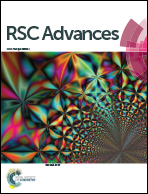Investigation of the interaction of batatasin derivatives with human serum albumin using voltammetric and spectroscopic methods
Abstract
Applying voltammetric, spectroscopic, and molecular docking technology, the binding properties of batatasin derivatives with HSA were systematically estimated. Cyclic voltammetry (CV) and differential pulse voltammetry (DPV) results showed that the common irreversible oxidation peaks of these compounds at 0.50–0.60 V were an adsorption process with equal numbers of electrons and protons. These compounds could interact with HSA and form non-electroactive complexes, at a binding ratio of 1 : 1. Comparing their association constants with HSA, 2-hydroxy-3,5-dimethoxy-bibenzyl was the strongest, following by demethyl batatasin IV, 2,3-dihydroxy-bibenzyl and 2-(1-phenethyl)phenol which were basically comparable. The equal fluorescent emission point proved further that these compounds interacted with HSA indeed and new complexes generated. The compounds caused a large reduction of α-helix structure in HSA and extension of its peptide chain which were proved by UV-Vis and CD spectrometric results. Molecular docking results directly demonstrated that the compounds bound near Trp-214 in subdomain IIA mainly through hydrogen bonds.


 Please wait while we load your content...
Please wait while we load your content...